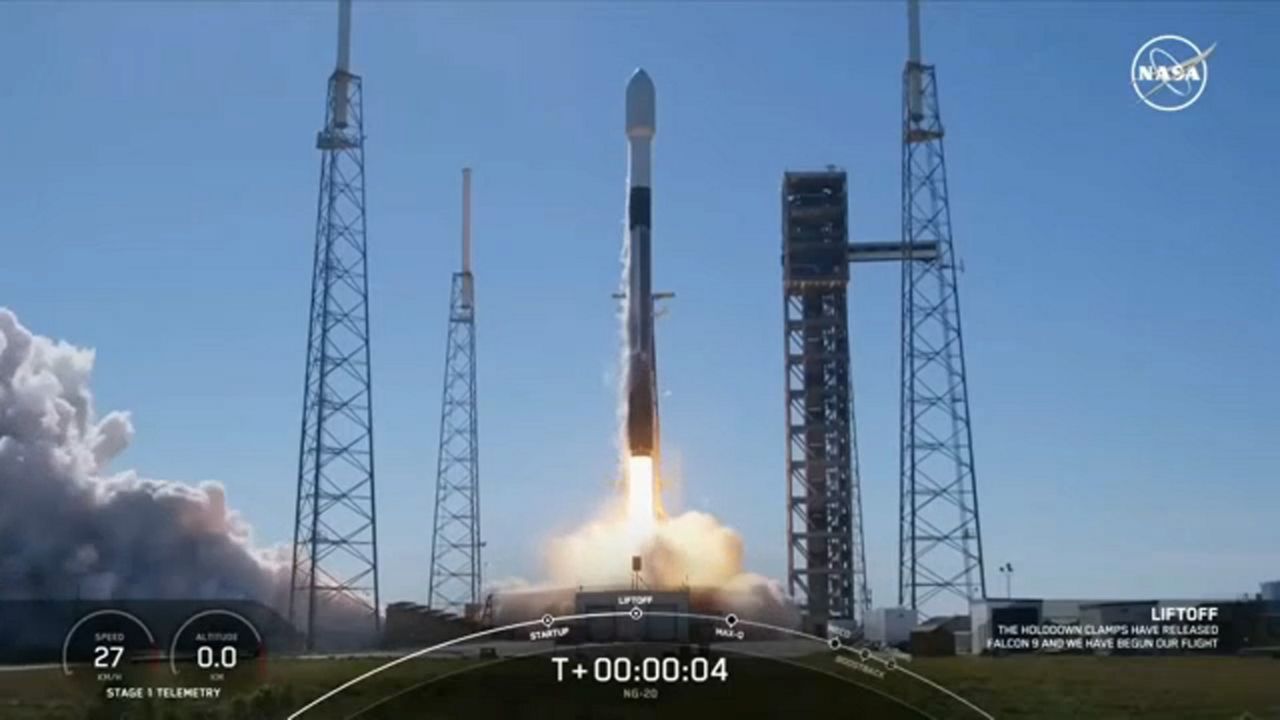CAPE CANAVERAL SPACE FORCE — SpaceX has successfully sent up Northrop Grumman’s Cygnus spacecraft, as it will carry more than 8,000 pounds of experiments and supplies to the International Space Station on Tuesday afternoon.
What You Need To Know
- The instantaneous launch window opened at 12:07 p.m. ET
- SpaceX launched Northrop Grumman’s Cygnus spacecraft
- The uncrewed spacecraft will carry supplies and experiments to the ISS
- The experiments are from both NASA and its partners
- Get more space coverage here ▶
- 🔻Scroll down to watch the launch🔻
LIFTOFF! @SpaceX @northropgrumman @NASA @Space_Station #Falcon9 #Cygnus @MyNews13 #News13Brevard pic.twitter.com/e0jjnBtbeW
— Greg Pallone (@gpallone13) January 30, 2024
As the instantaneous launch window opened at 12:07 p.m. ET, the company’s Falcon 9 rocket left from Space Launch Complex 40 at Cape Canaveral Space Force Station, stated SpaceX.
If it did not go up, there was a backup launch attempt schedule for Thursday, Feb. 1, at 11:18 a.m. ET.
Liftoff of Falcon 9 and Cygnus! pic.twitter.com/VgZq7N6jtm
— SpaceX (@SpaceX) January 30, 2024
The first-stage booster landed at Landing Zone 1 at Cape Canaveral Space Force Station after causing a cracking sonic boom that was heard for miles around.
Falcon 9's first stage returned to Earth and landed at Landing Zone 1, completing our 10th launch and landing of the year pic.twitter.com/MoqpgEt2hg
— SpaceX (@SpaceX) January 30, 2024
NASA stated that the uncrewed Cygnus spacecraft that is being used in Northrop Grumman’s 20th Commercial Resupply Services (NG-20 mission) will be caught by the ISS’s robotic arm at around 2:45 a.m. ET, on Thursday.
“After capture, the spacecraft will be installed on the (the ISS’s) Unity module’s Earth-facing port,” stated NASA.
The Cygnus spacecraft will stand on the module for about six months until it is released in May, where it will burn up in Earth’s atmosphere, the space agency noted.
Heading to the ISS
The Falcon 9 first-stage booster that will be used for this mission is called B1077 and it already has nine successful missions to its name.
- Crew-5
- GPS III Space Vehicle 06
- Inmarsat I-6 F2
- CRS-28
- Intelsat G-37
- Starlink mission 5-10
- Starlink mission 6-13
- Starlink mission 6-25
- Starlink mission 6-33
Learning about the Cygnus spacecraft
This will be Northrop Grumman’s 20th commercial resupply services mission to the ISS, but it will be the first time it will be riding on top of SpaceX’s Falcon 9 rocket, stated NASA.
The multinational aerospace and defense technology company, based in Virginia, will be using its Cygnus cargo spacecraft, or freighter, for the mission.
Using the Cygnus in the past, Northrop Grumman has delivered more than 130,000 pounds of cargo total to the ISS.
“Cygnus consists of a Service Module and a Pressurized Cargo Module that carries crew supplies, equipment and scientific experiments to destinations in low-Earth orbit,” stated the company, adding that the spacecraft has met NASA’s safety requirements.
The Cygnus spacecraft has been christened S.S. Patricia “Patty” Hilliard Robertson in honor of the late NASA astronaut, both Northrop Grumman and NASA stated. Robertson was supposed to fly to the ISS in 2002, but she died the year before in a private plane crash.
What’s in the spacecraft?
For the NG-20 mission, more than 8,200 pounds of supplies will be sent to the ISS. This includes science experiments, crew supplies and lab hardware for the famed floating laboratory.
Some of the highlighted experiments from both NASA and national and international partners and universities that will be sent up are:
Metal 3D printer: Among other things, it will 3D print small metal parts in microgravity.
“Results could improve understanding of the functionality, performance, and operations of metal 3D printing in space, as well as the quality, strength, and characteristics of the printed parts,” NASA described.
Modeling Atmospheric Re-entry: In an effort to protect experiments returning to Earth from the ISS and surviving the extreme heat of re-entry, this experiment will use three different heat shield materials and use different sensors to get data on the actual conditions of returning to Earth.
Remote Robotic Surgery: This small robot will be controlled remotely from NASA to perform surgical procedures. Before operating on a real person, with its two hands, it will hold on to and cut simulated tissue, among other things.
“Researchers plan to compare procedures in microgravity and on Earth to evaluate the effects of microgravity and time delays between space and ground,” NASA explained.
Growing Cartilage Tissue in Space: “Janus Base Nano-Matrix (JBNm) and Janus Base Nanopiece (JBNp). JBNm is an injectable material that provides a scaffold for the formation of cartilage in microgravity, which can serve as a model for studying cartilage diseases. JBNp delivers an RNA-based therapy to combat diseases that cause cartilage degeneration,” NASA explained.
Because microgravity can trigger cartilage degeneration, the research in microgravity could lead to faster treatments that can be both used in future missions to the moon and Mars but also here on Earth, NASA explained.
Get more details about the experiments here.




